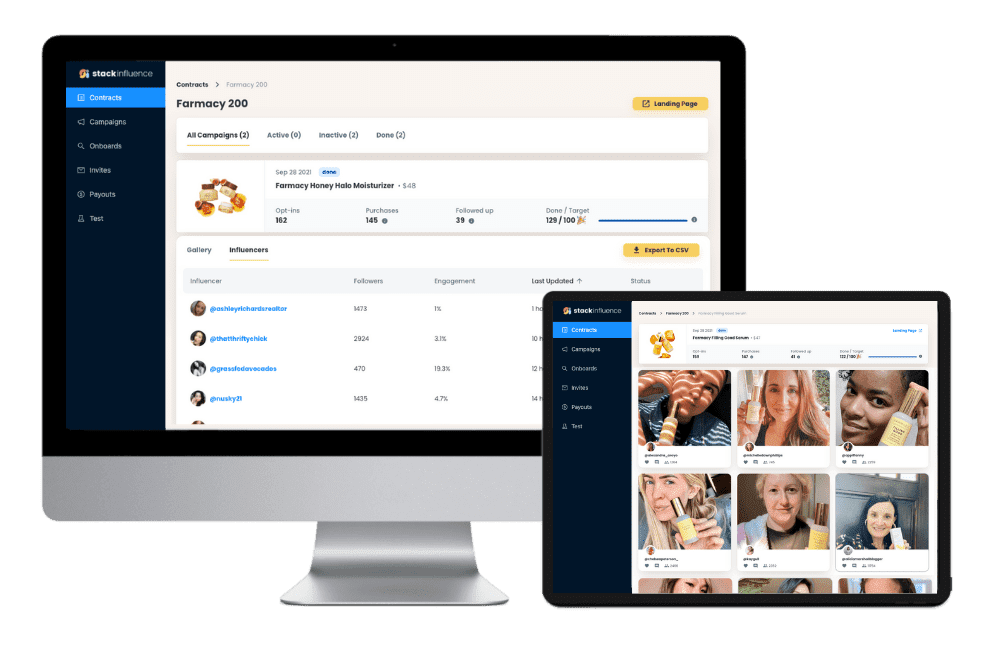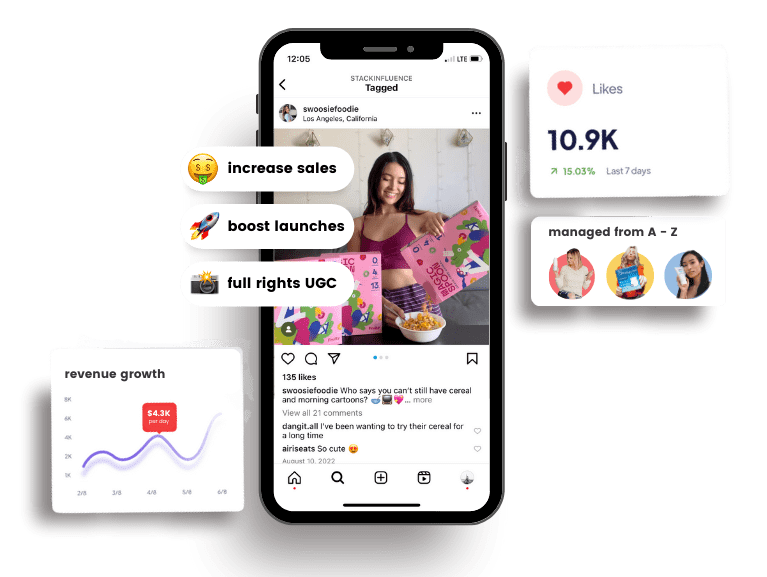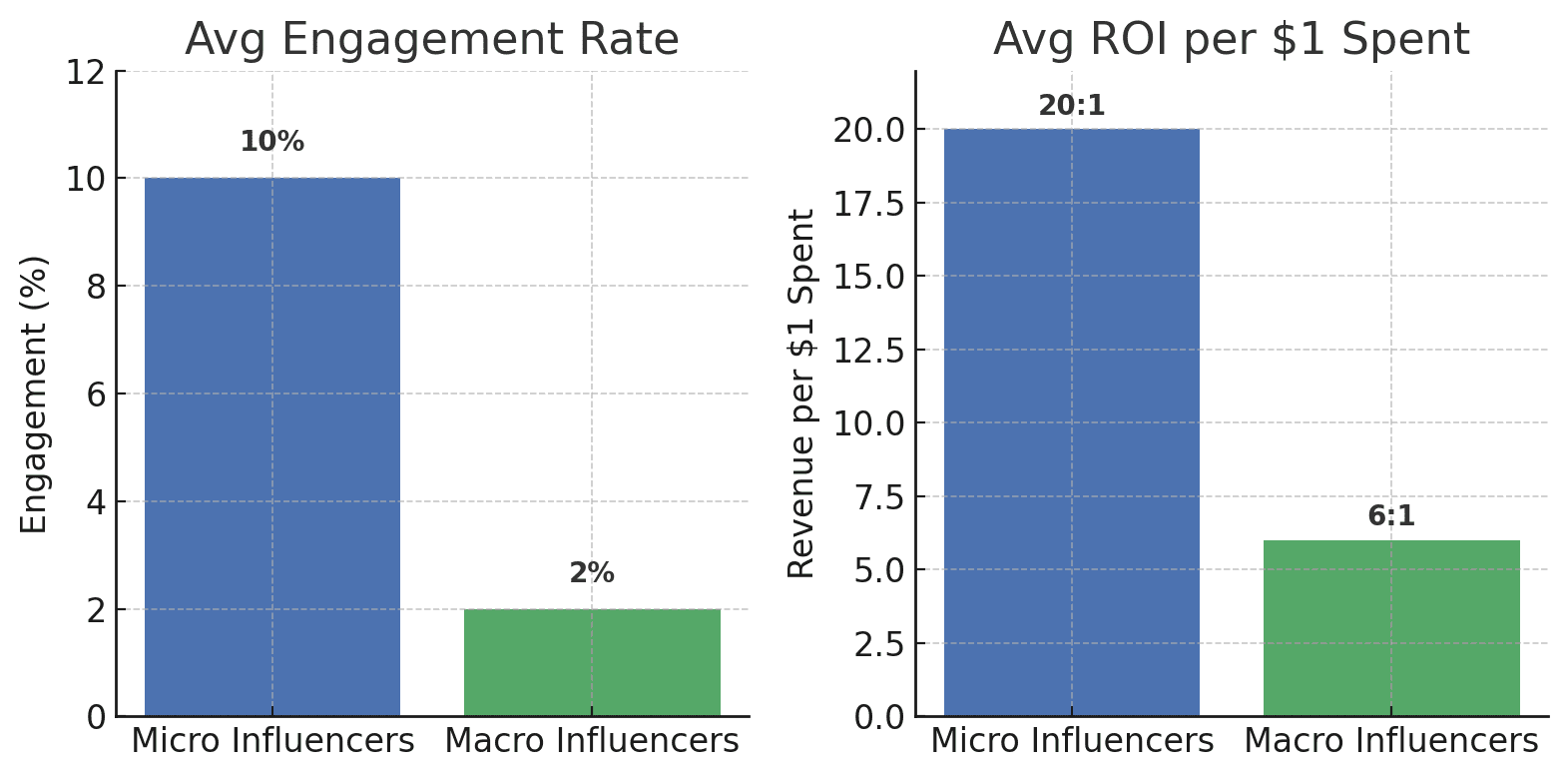Instagram Story Ads Examples: Influencers & E-Commerce Strategies for Success
6th
October, 2025
Influencer Marketing
Amazon Marketplace
Artificial Intelligence
TikTok Tips
Instagram Story ads have become a powerhouse for e-commerce brands – especially when paired with influencers and authentic content. These full-screen vertical ads offer a dynamic way to showcase products and drive quick actions from viewers. In fact, recent case studies show that Instagram Story ad campaigns can achieve 73% higher click-through rates, an 18% boost in sales, and a 41% increase in product page views for businesses. And it’s not just about numbers – consumers genuinely respond to this format. Every second Instagram user reports feeling greater interest in a brand or product after seeing an Instagram Story Ad.
In this article, we’ll explore why Instagram Story ads are so effective for e-commerce, how influencers (especially micro-influencers and content creators) and user-generated content (UGC) can supercharge these ads, and we’ll look at real examples of brands knocking it out of the park. We’ll also cover what brands should ask of influencers when collaborating on Story ad campaigns. Whether you’re an Amazon seller, a DTC e-commerce brand, or a marketer looking to boost engagement, read on for tips to optimize your Story ads for maximum impact.

Unlock the Power of Micro Influencers and Elevate your Brand Today!

Why Instagram Story Ads Matter for E-Commerce
Instagram Stories offer a unique blend of engagement and urgency that other formats struggle to match. They appear at the top of the app and take up the entire screen, which means a viewer’s full attention is on your content. Story ads leverage the “tap-through” behavior users love – delivering quick, immersive snippets that can lead directly to a swipe-up (or click) action. A few key reasons Story ads work so well for online brands include:
- Higher Engagement: Instagram Stories naturally invite interaction. Users tap through Stories rapidly, so a well-crafted ad that matches the mobile-native design of Stories can stop thumbs and hold attention. Instagram’s data shows Stories get more engagement than static feed posts since they occupy more screen real estate and feel more personal. With features like polls, quizzes, and sliders, Story ads can encourage direct audience participation in ways a regular feed ad cannot.
- Urgency and FOMO: Stories are ephemeral – they disappear after 24 hours (for organic stories) and Story ads can’t be saved or easily revisited. This creates a FOMO effect. Viewers know they have to act quickly or the opportunity might be gone. For brands, this is gold: a limited-time offer or flash sale promoted via Story ad can push viewers to “swipe up now” rather than “maybe later.” This urgency often translates into higher conversion rates for promotions.
- Seamless Shopping: The swipe-up link (or “link sticker” now available to all accounts) lets Story ads drive traffic directly to product pages, Amazon listings, or app downloads without friction. For example, restaurant app Dineout found that adding Stories to its ad mix decreased its cost-per-app-install by 17% and cost-per-purchase by 39% – showing how effective that instant action can be. E-commerce brands can tag products or link straight to a checkout, making impulse purchases one tap away.
- Seamless Integration with Facebook/Instagram Ads: If you’re running ads via Meta Ads Manager, you can specifically choose Stories placement or let automatic placement include Stories. Many successful campaigns use a consistent creative theme across feeds and Stories for better recall, or even create Story-specific content to maximize vertical video potential. The key is that Story ads, as part of a broader campaign, often amplify results (as we’ll see in examples below).
In short, Instagram Story ads combine attention-grabbing visuals with an immediate call-to-action, which is ideal for e-commerce conversion. But the real magic happens when you add influencers and UGC into the mix.
The Power of Influencers, Micro-Influencers & UGC in Story Ads
One reason influencer-powered Story ads perform so well is trust. Influencers – particularly micro-influencers (those with smaller, highly engaged followings) – come across as authentic and relatable. Their content feels like a friend’s recommendation rather than a traditional ad, and that authenticity pays off. Nearly 90% of consumers say authenticity is important when deciding which brands to support, and user-generated content (UGC) is viewed as the most authentic form of media by consumers. An Instagram Story featuring a real person (like a content creator or happy customer) using a product can instantly build credibility in a way studio-shot ads often can’t.
Moreover, micro-influencers tend to have hyper-engaged audiences in specific niches – which is perfect for targeting. While a celebrity might reach millions with a broad message, a micro-influencer (say a fitness enthusiast with 20k followers) can sway a tight-knit community of true believers. This translates into measurable performance benefits:

Chart: Comparison of average engagement rates and ROI for micro-influencers vs. macro-influencers. According to data from Stack Influence (a micro-influencer marketing platform), micro-influencers see roughly a 10% engagement rate on their content, versus only about 2% for macro influencers. They also deliver a far higher bang for the buck – campaigns with micro-influencers can yield around a 20:1 return on investment, compared to ~6:1 ROI for campaigns using big-name influencers. In practical terms, that means $1 spent on a micro-influencer campaign can generate ~3× more sales than $1 spent on a celebrity influencer. This higher ROI is partly because micro-influencers are more cost-effective to work with, and partly because their followers are highly responsive to their content (a recommendation feels like it’s coming from a trusted peer).
Micro-influencers and content creators also excel at producing UGC-style content that doesn’t look like a slick corporate ad. That’s a huge plus for Story ads. Blending in with the native Story feed – while still delivering a marketing message – is a balancing act. Content that looks too polished might be skipped as “just another ad.” But an influencer’s Story, shot on a phone camera, speaking in their natural voice, feels real. Viewers are more likely to pay attention, and even click through at higher rates – UGC-based ads often see significantly higher CTR and lower CPC than traditional ads.
Authentic influencer content can be leveraged in two ways on Stories:
- Influencer-Posted Stories (Organic + Paid Partnership): A brand can have an influencer post Stories on the influencer’s own account, promoting the product. These can be simply organic (with the influencer tagging the brand, using a promo code, etc.) or marked as a “Paid Partnership”. Brands often repost this content to their own Story as well. While these aren’t ads in the technical sense, they function like them – and you can amplify their reach via Instagram’s Boost or by whitelisting the influencer’s content for ads. The benefit here is tapping directly into the influencer’s follower base with a message that feels like a genuine endorsement.
- Brand-Posted Story Ads Using Influencer Content: Brands can also take content created by influencers (photos, videos, testimonials) and run them as Story ads from the brand’s account. This is common in “UGC ads” where the creative might show an influencer or customer talking about the product. Even though it’s running as a paid ad, it’s essentially user-generated content in style – often more relatable than a typical ad. As noted, these UGC-style Story ads tend to perform extremely well in terms of engagement and conversion because they come off as word-of-mouth recommendations.
A combination of these approaches can yield the best results: for instance, an influencer posts a series of Stories about your product to their audience, and you also run a few of those Story slides as targeted ads to reach new customers. You get both the immediate promotion to the influencer’s fans and ongoing value by repurposing that content in ads and on your own channels. This one-two punch is powerful, especially for small brands trying to build social proof.
It’s worth mentioning that Amazon sellers have also caught onto the influencer + Story ads trend. Amazon’s Influencer Program enables creators to have their own Amazon storefronts with recommended products. Influencers often promote these via Instagram Stories using swipe-up links to Amazon. This means if an Amazon seller’s product is featured in an influencer’s Story, viewers can go directly to Amazon to buy it – a seamless path that leverages the trust of the influencer and the convenience of Amazon. The kicker: all that external traffic and sales can boost the product’s ranking on Amazon itself. As one analysis noted, when influencers drive their followers to Amazon for a product, it creates a virtuous cycle – the influx of purchases can improve the item’s search rank on Amazon, leading to even more organic sales. For Amazon-focused e-commerce brands, integrating Instagram Story promos by content creators is an effective way to stand out in a competitive marketplace and drive sustained growth.
To summarize, micro-influencers and UGC content are the secret sauce for many high-performing Story ads. They bring authenticity, trust, and better ROI. E-commerce brands (from Shopify entrepreneurs to Amazon marketplace sellers) can greatly benefit by incorporating influencer-driven content in their Instagram Story advertising strategy. Next, let’s look at some real-world examples of how brands are doing this successfully.
Examples of Successful Instagram Story Ad Campaigns
Nothing beats real examples to spark inspiration. Below are a few standout Instagram Story ad campaigns by e-commerce brands and how they leveraged influencers or creative storytelling to get results. These examples show different approaches – from using familiar influencer faces to slick design – and the kind of outcomes possible:
- Tokopedia (Indonesia) – “Influencers + Story Ads for Big Wins”
Tokopedia, a leading online marketplace, ran an extensive year-end campaign combining influencer content with Instagram Story ads. Their objectives were to engage a young Instagram-savvy audience and drive traffic & conversions on their platform. They partnered with popular local influencers as the “face” of the ads and also ran Story ads optimized for conversions, including retargeting past visitors. The results were dramatic: in just 3 days, Tokopedia saw a 2.2× increase in unique store visits, a 67% increase in product page views, and 2× the sales for the featured products. By featuring familiar influencer personalities in the creative, they immediately caught the attention of their target audience. The campaign takeaway was clear – use influencers as the face for your ads. Tokopedia reported that recognizable, trusted faces helped bolster audience connection and engagement. This case shows how blending influencer-driven UGC with paid Story placements can skyrocket e-commerce metrics in a short time. - Gymshark – “Product Launch Hype with Stories”
Gymshark, the popular fitness apparel brand, turned to Instagram Stories to launch its “Flex” activewear line – and showed how Story ads can drive direct sales. The ad creative was simple but effective: a static image of the new product line, jazzed up with vibrant colors, bold text, and a clear call-to-action (“Shop now”). No fancy video, just a well-designed Story slide that fit the brand’s aesthetic. The impact? Gymshark’s Story ad generated 2,400 orders for the new line and an impressive 9× return on ad spend (ROAS) according to Instagram’s case study. This success came from a combination of eye-catching design and a targeted ad push to the right audience. It proves that you don’t always need a celebrity influencer – a strong creative and a beloved brand can itself drive huge results – but the format (full-screen Story with a timely message) was key. Gymshark effectively created a sense of urgency and exclusivity around the launch via Stories, and it paid off in spades. - Revolve – “Editorial-Style Stories that Convert”
Revolve, a fashion e-commerce giant well-known for influencer marketing, decided to overhaul its Instagram Story ad approach to stand out in a crowded space. Instead of typical user-generated style content, Revolve invested in high-design, magazine-quality Story ad templates (in partnership with a creative studio) to make their ads feel like polished mini-campaigns. They incorporated sleek animations, curated outfit showcases, and on-brand typography in their Story videos. The idea was to combine the engaging format of Stories with the look of a fashion editorial – effectively making the ads feel like aspirational content, not just adverts. The strategy was a hit: Revolve’s revamped Story ads led to a 417% increase in purchases on average and a 9× ROAS, along with significant jumps in swipe-through engagement. By marrying high production value with the fast-paced Story format, Revolve proved that if done thoughtfully, Story ads can both dazzle and sell. Even in “a space overflowing with influencer content,” Revolve’s distinct approach made their ads memorable and effective. The key insight here is to align your Story ad creative with your brand’s identity – whether that’s raw and authentic or sleek and curated – and always include strong calls-to-action to convert that interest into action.
(Other honorable mentions: Many other brands have seen success with Story ads. Music streamer Deezer adapted their video ads into Story format and cut acquisition cost by 52% while doubling conversion rate. Beauty start-up Memebox used sequential Story ads (including a tutorial-style clip with a model using the product) to boost brand awareness and prompt swipes to their site, demonstrating that showing a product in action via Stories can nudge curious viewers into customers. And big names like Maybelline have leveraged influencer takeovers on Stories – letting an influencer demo products on the brand’s Story – to humanize their marketing and drive product interest. The pattern across these examples is clear: Instagram Stories + engaging content (often with a human touch) = a recipe for growth.)*
What Should Brands Ask Influencers for Instagram Story Ads?
If you’re an e-commerce brand teaming up with an influencer (or multiple micro-influencers) for a Story ad campaign, it’s crucial to set clear expectations. Influencer collaborations can fall flat if details are misunderstood. Here’s a handy checklist of what brands should ask for and communicate to influencers when planning Instagram Story ads:
- Clear Deliverables: Specify exactly what content you need the influencer to create. For example, “3 story frames (15 seconds each) showing an unboxing and demo of the product, plus a swipe-up link on the last frame.” Define the number of Story slides, any particular format (photo, talking-to-camera video, boomerang, etc.), and whether they need to post multiple times or on specific dates. Being clear upfront ensures the influencer knows the scope (and it should be in your agreement/contract).
- Key Message & CTA: Let the influencer know the core message or product features you want highlighted, but also give them creative freedom to put it in their voice. Importantly, ask them to include a strong call-to-action. This could be a verbal prompt like “Swipe up to shop!” or a visible link sticker with text like “Shop Product.” If the influencer doesn’t have 10k followers (historically the requirement for swipe-up, though link stickers removed that limit), discuss alternative CTA options (e.g., “link in bio” or a promo code shout-out). The goal is to have a clear next step for viewers – don’t assume the influencer will remember to add that on their own.
- Brand Assets & Guidelines: Provide the influencer with any necessary brand assets (like your logo, product images, or a specific hashtag) and guidelines. For instance, you might ask that your brand’s Instagram handle is mentioned or tagged in every frame of the Story for visibility. If you have preferred color schemes, fonts, or music you’d like them to use (or avoid), let them know. However, be careful not to micromanage their creative style – influencers know their audience best. Aim for a balance: the content should feel authentic to the creator and aligned with your brand. A good influencer will appreciate clear guidelines like “Please make sure to show the product packaging and mention our discount code, but otherwise we trust your creative direction.”
- Disclosure & Authenticity: It’s essential (and legally required in many regions) that sponsored content is disclosed. Make sure to ask the influencer to clearly disclose the partnership, either via Instagram’s built-in “Paid Partnership” label or a simple #ad or #sponsored tag on the Story. Beyond legal compliance, transparency actually builds trust with the audience – which is what you want. Also encourage the influencer to be honest and personal in how they talk about your product. Audiences respond well to genuine enthusiasm and even acknowledging an ad (“You guys know I only partner with brands I truly love – and honestly, this gadget has been so useful… [product demo]”). Authenticity is key to UGC, so ensure the influencer feels comfortable and genuine promoting your item.
- Posting Details & Timing: Clarify when the Story should go live and if there are any timing considerations. For example, if you’re running a 48-hour flash sale, the Stories should be posted at the start of that window. Or if you know your target audience is most active in the evenings, you might request the influencer post then for maximum views. Also confirm whether the influencer needs to save the Story to their Highlights (if it’s something you want people to see beyond 24 hours). Some brands also coordinate multiple influencers to post around the same time or day to create a bigger splash – timing can amplify impact, so align on it beforehand.
- Swipe-Up Link or Code Setup: If you’re providing a special tracking link or promo code, ensure the influencer has it well in advance. Test the link to make sure it’s working and is the correct destination (your website, Amazon page, etc.). Instruct the influencer how to add the link sticker in the Story (most seasoned creators know, but it never hurts to double-check). If using a promo code (e.g., INFLUENCER20 for 20% off), ask them to mention it verbally and overlay it as text on the Story so viewers catch it even without sound. These little details will help you attribute sales directly to the campaign and also provide something of value to the audience (a discount or easy path to purchase).
- Insights & Performance Sharing: One unique aspect of Stories is that they vanish, but their impact can be measured in Instagram’s Insights (for the creator) and in your own analytics (if using UTM links or codes). Arrange with the influencer to get the performance data from their Story post. Key metrics include Story views, reach, taps forward/back, exits, and especially link clicks or swipe-ups. Many influencers will happily share screenshots of their Instagram Story Insights for the campaign – but you need to ask. This data is gold for you to calculate ROI and learn which content resonated. If you’re running the content as an ad through your account, you’ll get the metrics in Ads Manager, but it’s still useful to see how the organic posting did on the influencer’s side.
- Content Rights (Repurposing UGC): Since influencers are essentially creating UGC for your brand, it can have life beyond just the 24-hour Story. It’s wise to negotiate rights to reuse the content. Ask the influencer for permission (preferably written, in your contract or agreement) to reuse the Story content in your own marketing – for example, reposting it on your feed, turning it into a sponsored Story ad from your account, or using the video on your website. Many micro-influencers are okay with granting full usage rights or will do so for an added fee. Having these rights allows you to amplify the content further (remember, UGC-based ads often outperform standard creatives). A piece of influencer content can thus continue to generate value long after the initial Story post – essentially becoming an asset in your content library.
- Mutual Engagement: For a truly successful collaboration, it helps if the brand also shows love to the influencer. Plan to share or shout-out the influencer’s Story from your brand account (e.g., repost it to your Story or create a highlight of “Influencer Features”). This not only gives the influencer extra exposure (which they appreciate), but also signals to your own followers that real people are endorsing your product. It’s UGC social proof in action. You can ask the influencer if they’re comfortable with you reposting their content (most will be). Additionally, consider asking if they’d be open to responding to follower questions that come in via DMs after the Story – often a well-placed Story will trigger direct messages from interested viewers (e.g., “Is that product legit? Does it come in other colors?”). An engaged influencer who replies and interacts can push those considering viewers closer to conversion, which benefits everyone.
By covering these bases, brands can ensure their influencer partnerships for Story ads run smoothly and deliver results. Essentially, you want to arm the influencer with the right tools and information to tell a compelling story (pun intended) that also meets your marketing goals. It’s all about collaboration – you bring the campaign goals and product knowledge, they bring the creativity and audience connection.

Unlock the Power of Micro Influencers and Elevate your Brand Today!

Conclusion to Instagram Story Ads Examples
Instagram Story ads represent a unique meeting point between engagement and conversion – and when you add influencers and micro-influencers to the mix, they become even more potent. We’ve seen how e-commerce brands can leverage the authenticity of content creators and UGC to create Story ads that not only catch eyeballs but also drive action. Whether it’s a micro-influencer’s casual demo that lends credibility to a new gadget, or a bold Story ad announcing a flash sale, the formula is similar: keep it real, keep it relevant, and make it easy for the viewer to act.
For brands big and small (from independent Shopify stores to global Amazon sellers), the takeaway is clear: don’t sleep on Instagram Stories as an ad channel. They’re perfect for the mobile shopper era – quick, engaging, and actionable. By collaborating with the right influencers (and using platforms like Stack Influence to find and manage micro-influencers at scale), you can tap into personal, trusted storytelling at scale. The result, as evidenced by the examples like Tokopedia, Gymshark, and Revolve, can be a significant boost in traffic, sales, and ROI.
As you craft your next campaign, remember to measure what works, be willing to test different creative approaches, and let the human side of your brand shine through. Instagram is a place for connections and inspiration – if your Story ads can deliver both, they’ll not only stop the scroll but also spark the sales. Here’s to creating thumb-stopping, story-selling content that resonates in 2025 and beyond!

By William Gasner
CMO at Stack Influence
William Gasner is the CMO of Stack Influence, he's a 6X founder, a 7-Figure eCommerce seller, and has been featured in leading publications like Forbes, Business Insider, and Wired for his thoughts on the influencer marketing and eCommerce industries.
Want new articles before they get published? Subscribe to our Awesome Newsletter.
stack up your influence
turning creativity into currency
our headquarters
111 NE 1st St, Miami, FL 33132
our contact info
[email protected]
stack up your influence
turning creativity into currency
our headquarters
111 NE 1st St, 8th Floor
Miami, FL 33132


